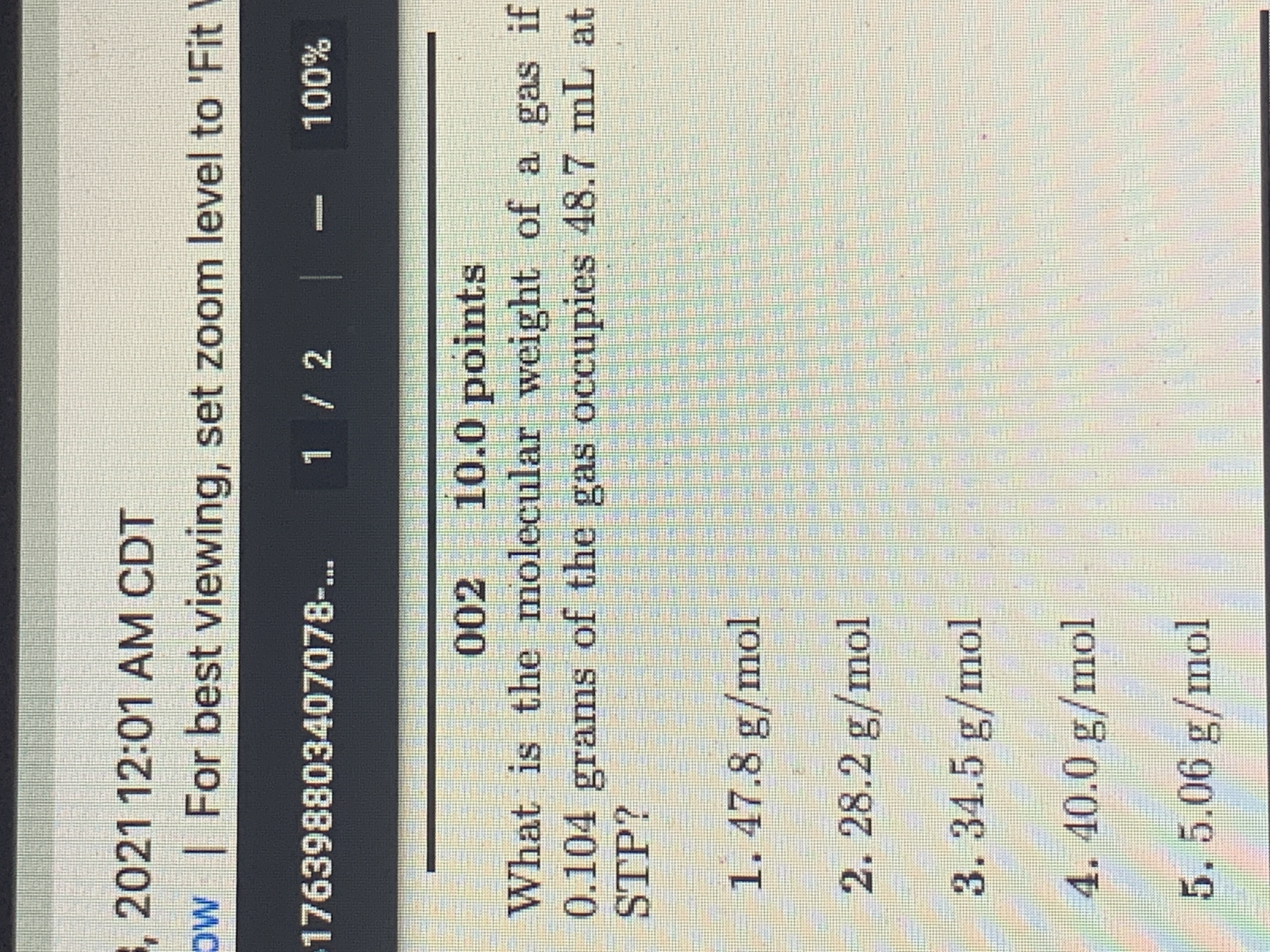
Chemistry
10th Edition
ISBN: 9781305957404
Author: Steven S. Zumdahl, Susan A. Zumdahl, Donald J. DeCoste
Publisher: Cengage Learning
expand_more
expand_more
format_list_bulleted
Question
What would be the molecular weight of a gas

Expert Solution
This question has been solved!
Explore an expertly crafted, step-by-step solution for a thorough understanding of key concepts.
This is a popular solution
Trending nowThis is a popular solution!
Step by stepSolved in 2 steps with 1 images

Knowledge Booster
Learn more about
Need a deep-dive on the concept behind this application? Look no further. Learn more about this topic, chemistry and related others by exploring similar questions and additional content below.Similar questions
- Aluminum reacts with chlorine gas to form aluminum chloride via the following reaction: 2Al(s)+3Cl2(g)→2AlCl3(s)2Al(s)+3Cl2(g)→2AlCl3(s) You are given 33.0 gg of aluminum and 38.0 gg of chlorine gas. Part A If you had excess chlorine, how many moles of of aluminum chloride could be produced from 33.0 gg of aluminum? Express your answer to three significant figures and include the appropriate units. Part B If you had excess aluminum, how many moles of aluminum chloride could be produced from 38.0 gg of chlorine gas, Cl2Cl2? Express your answer to three significant figures and include the appropriate units.arrow_forwardAccording to the following reaction:2C6H6 (l) + 15O2 (g) 12CO2 (g) + 6H2O (g)What would you multiply "moles of benzene (C6H6)" by to convert to the units "moles of water" ? moles C6H6 = moles H2O (number) (unit) (number) (unit)arrow_forwardAluminum reacts with chlorine gas to form aluminum chloride via the following reaction: 2Al(s)+3Cl2(g)→2AlCl3(s)2Al(s)+3Cl2(g)→2AlCl3(s) You are given 21.0 gg of aluminum and 26.0 gg of chlorine gas. Part A: If you had excess chlorine, how many moles of of aluminum chloride could be produced from 21.0 gg of aluminum? Express your answer to three significant figures and include the appropriate units. Part B: If you had excess aluminum, how many moles of aluminum chloride could be produced from 26.0 gg of chlorine gas, Cl2Cl2? Express your answer to three significant figures and include the appropriate units.arrow_forward
- Acetylene (C2H2) gas is often used in welding torches because of the very high heat produced when it reacts with oxygen (O2) gas, producing carbon dioxide gas and water vapor. Calculate the moles of oxygen needed to produce 1.30 mol of water. Answer with unit symbol and 3 sigarrow_forwardWhat does molar amount mean? Is it the same as molar mass or molarity?arrow_forwardWhat is the difference between molarity, molar and grams?arrow_forward
- How many moles of argon gas contain 7.52 x 1022 Ar atoms? 0.801 mol 1.25 mol 0.0801 mol 0.125 mol 0.0125 molarrow_forwardHow many moles are in 28.4 grams of water?arrow_forwardDraw a diagram representing what is in the container before and after the reaction for a closed container is filled with 2 moles of hydrogen gas and 2 moles of oxygen gas. The gases react to form water.arrow_forward
arrow_back_ios
SEE MORE QUESTIONS
arrow_forward_ios
Recommended textbooks for you
 ChemistryChemistryISBN:9781305957404Author:Steven S. Zumdahl, Susan A. Zumdahl, Donald J. DeCostePublisher:Cengage Learning
ChemistryChemistryISBN:9781305957404Author:Steven S. Zumdahl, Susan A. Zumdahl, Donald J. DeCostePublisher:Cengage Learning ChemistryChemistryISBN:9781259911156Author:Raymond Chang Dr., Jason Overby ProfessorPublisher:McGraw-Hill Education
ChemistryChemistryISBN:9781259911156Author:Raymond Chang Dr., Jason Overby ProfessorPublisher:McGraw-Hill Education Principles of Instrumental AnalysisChemistryISBN:9781305577213Author:Douglas A. Skoog, F. James Holler, Stanley R. CrouchPublisher:Cengage Learning
Principles of Instrumental AnalysisChemistryISBN:9781305577213Author:Douglas A. Skoog, F. James Holler, Stanley R. CrouchPublisher:Cengage Learning Organic ChemistryChemistryISBN:9780078021558Author:Janice Gorzynski Smith Dr.Publisher:McGraw-Hill Education
Organic ChemistryChemistryISBN:9780078021558Author:Janice Gorzynski Smith Dr.Publisher:McGraw-Hill Education Chemistry: Principles and ReactionsChemistryISBN:9781305079373Author:William L. Masterton, Cecile N. HurleyPublisher:Cengage Learning
Chemistry: Principles and ReactionsChemistryISBN:9781305079373Author:William L. Masterton, Cecile N. HurleyPublisher:Cengage Learning Elementary Principles of Chemical Processes, Bind...ChemistryISBN:9781118431221Author:Richard M. Felder, Ronald W. Rousseau, Lisa G. BullardPublisher:WILEY
Elementary Principles of Chemical Processes, Bind...ChemistryISBN:9781118431221Author:Richard M. Felder, Ronald W. Rousseau, Lisa G. BullardPublisher:WILEY

Chemistry
Chemistry
ISBN:9781305957404
Author:Steven S. Zumdahl, Susan A. Zumdahl, Donald J. DeCoste
Publisher:Cengage Learning

Chemistry
Chemistry
ISBN:9781259911156
Author:Raymond Chang Dr., Jason Overby Professor
Publisher:McGraw-Hill Education

Principles of Instrumental Analysis
Chemistry
ISBN:9781305577213
Author:Douglas A. Skoog, F. James Holler, Stanley R. Crouch
Publisher:Cengage Learning

Organic Chemistry
Chemistry
ISBN:9780078021558
Author:Janice Gorzynski Smith Dr.
Publisher:McGraw-Hill Education

Chemistry: Principles and Reactions
Chemistry
ISBN:9781305079373
Author:William L. Masterton, Cecile N. Hurley
Publisher:Cengage Learning

Elementary Principles of Chemical Processes, Bind...
Chemistry
ISBN:9781118431221
Author:Richard M. Felder, Ronald W. Rousseau, Lisa G. Bullard
Publisher:WILEY